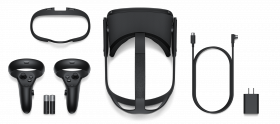
Why I chose the Oculus Quest over the Oculus Rift S
"Nah mate, don't get the Rift S, get the Quest" – a buddy of mine told me over a pint at our local watering hole.
I looked at him, dazed and confused, considering if I was a little too drunk to comprehend the words that had just come out of his mouth. I asked if he understood that I'm running a 2080 Ti-powered rig with a custom water-cooling loop and that my money would be wasted on a Quest. Especially considering it's marketed as a standalone, PC-free headset.
He continued to enlighten me on the fact that those YouTube comparisons that I made snap judgements on over a year ago were now outdated, and that the Quest was the obvious choice.
Here I am, three weeks later – wholly sold on the idea (after impulsively buying a Quest based on hearsay alone).
For starters, I can prance around my 2x2 meter play space completely untethered from my PC while enjoying Half-Life: Alyx. With a little bit of homebrew tweaking from easily accessible guides on the internet, the Quest can effortlessly stream down an Ethernet cable to your router, and from your router to your Quest with a strong 5GHz Wi-Fi connection. While testing the method, a friend confirmed that I was getting no more than 10ms of latency (and an average of 4ms) while awkwardly slicing my way through a Beat Saber track. Unless you plan on making a career for yourself as a professional Beat Saber player, that's quite alright for most people.
Of course, you also have the option of playing with Oculus Link, which has improved drastically since its early beta stages. For one thing, you no longer need to get the official Oculus-branded link cable to get the most out of it. As a matter of fact, I've gotten along just fine with the 3-meter charging cable included in the box. I exercise this option when playing rhythm games such as Synth Riders and Beat Saber most often, as those sorts of titles don't require much turning. Consequently, the presence of a cable isn't really felt. You also have the peace of mind that your 300 note streak is less likely to be interrupted as a result of a spike in wireless interference. Interference is not a common occurrence (at least in my environment), but a caveat to that method of connectivity.
Another perk the Quest has over the Rift S (even if you have a high-end gaming rig) is the ongoing support the Quest is receiving from Oculus. New beta features for the Quest are continually being added in new software builds – not limited to but including hand tracking and voice commands (for US English speakers). Meanwhile, the Rift S seems to be receiving drastically less ongoing support and updates and is quickly falling behind the Quest's ever-increasing list of features. As a matter of fact, the Rift S hasn't seen a new software build since April this year. Personally, I would rather take the small dip in refresh rate over the maker of the hardware seemingly abandoning ongoing support for the product I've spent my hard-earned cash on.
It goes without saying that the Quests portability is also a strong factor. The fact that it has its own self-sufficient operating system and battery means you can quickly bring your Quest around to your mates' house and enjoy some socially distant rounds of Keep Talking and Nobody Explodes. To pull off the same feat with a Rift S, you'd need to be lugging around your entire gaming rig in the boot of your car.

Everything you need to bring VR to your friends. (Travel case also sold separately)
There is one caveat to the Quest which I should mention – which is the startup cost. If you want the best possible experience with this headset, you're going to want to invest in a few creature comfort upgrades. For instance, I can only get 2-3 hours of battery at best out of a session of Half-Life: Alyx when streaming it via Virtual Desktop. If that is bothersome to you, you'll want to consider modifying the headset to have some form of power bank on the back of the device, which can also serve as a counterweight.
On that topic, the Quest is also quite front heavy – due to having so much more hardware than the Rift S stored in the front of the headset. Straight out of the box, I did not find the Quest to be very comfortable for more than 30 minutes at a time. So, I also invested in a more comfortable head strap which spreads the weight of the Quest a little more evenly around my massive head.
Additionally, if you're looking to exercise the wireless PC streaming option, you're going to need to purchase a copy of Virtual Desktop, which set me back around 20 AUD.
The point I'm trying to make is, if you want the most out of your Quest experience, expect to pay a few more dollars on top of the cost of the headset itself for a truly optimal experience with it.
Otherwise, my blind faith in a drunken conversation down at the pub ended up coming through tenfold. Even though I'm running a top-notch PC rig which could run the Rift S with its eyes closed, I'm glad I went for the left-field option of the Quest. This device simply has too much utility to turn your nose up at.









COMMENTS